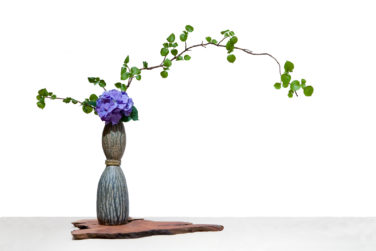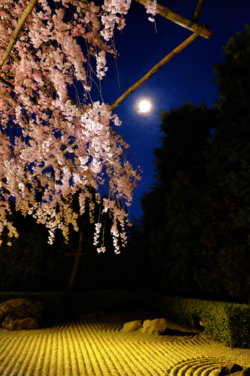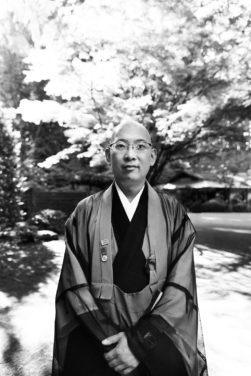Musings from Diane Durston, Curator Emerita
As the last of the cherry blossoms cling to the trees, and the sunshine this spring reminds us that the beauty of nature transcends hard times.

This year, we missed the celebration of Hana Matsuri, the Flower Festival, at the Garden. Observed with an exhibition of Ikebana by the Saga School every year on April 8, the heart of the festival as a Buddhist observance in honor of the Buddha’s birthday on that date. At Portland Japanese Garden, a Buddhist ceremony led by a priest of the Shingon sect associated with the Saga School chants from scripture before a statue of the Buddha which is enshrined on an altar of flowers. The faithful take turns “ladling sweet tea over the statue representing the gentle rain that fell in Lumbini Grove and bathed the baby Buddha in sweet holy water,” according to the Garden’s website
Buddhists all over the world observe April 8, and this year our friend Rev. Daiko Matsuyama, of Taizo-in temple in Kyoto sent me a special message last week to mark the occasion with a story to comfort us in difficult times.

He wrote:
“The thief left it behind:
the moon
at my window”
–Ryokan (1758-1831)
Ryokan was one of the most famous Zen monks who represented the Edo period.
Even though he was a highly respected monk, he was affectionately called “Ryo-kan-san” by everyone. From children to the elderly, he treated everyone without distinction.
There was a shabby hermitage called Gogoh-an, where he lived. One cold winter night, a thief came in. However, Ryokan lived a very poor, simple life, so he had no savings nor valuables. The thief reluctantly tried to steal the cushion that Ryokan was sleeping on. He knew the thief was there, but he pretended to be asleep and rolled out of it to make it easier to get it. After confirming the thief was no longer there, Ryokan composed this poem, looking out the window from his empty room. The moon still remained.
Reverend Matsuyama went on to say,

“Money, important jobs, travel plans, and appointments with friends. I’m sure the coronavirus has robbed you of many things. I myself have been very much affected.
But if you take a look around, you’ll see that the virus hasn’t taken everything. Real important things remain close to us.
What is the “moon” for us? We don’t usually notice it, but I thought it would be a good reminder. I will try to enjoy the moment and make the most of the day.
Finally, Reverend Matsuyama added this poem and a photo he had taken of the moon above the weeping cherry tree in his exquisite garden:
“The virus left it alone:
The sakura
under the moon”
–Daiko (2020)
Reverend Matsuyama, we thank you for this reminder, and wish you and everyone in Japan the same.
Diane Durston is the author of Wabi Sabi: The Art of Everyday Life, a collection of quiet meditations on life lived simply and with intention, and three books on Kyoto (available online).
—————
Photo and text excerpts courtesy of Reverend Daiko Matsuyama, Vice Abbott of Taizo-in, a subsidiary Zen monastery in Western Kyoto.
Taizo-in is one of the oldest Zen temples in Kyoto. Established in the 14th-century, the temple is no stranger to disastrous times, having suffered the ravages of fire, flood, famine, and warfare over the centuries. It continues today to spread the reassuring messages of Buddhism throughout the world through the efforts of young Reverend Matsuyama. He first spoke in Portland at the Garden’s invitation in 2016.
Visit Taizo-in’s website in English to learn more:
